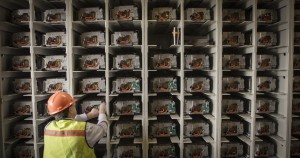 The Washington Post picks up on the thread of how valuable energy storage (i.e. batteries) can be for the grid when paired with solar panels:
The Washington Post picks up on the thread of how valuable energy storage (i.e. batteries) can be for the grid when paired with solar panels:
So is it happening? The answer seems to be yes — 2015 has seen several key announced, completed, or experimental grid-scale projects pairing batteries and solar photovoltaic panels.
“In the last few months we’ve seen the frequency of these project announcements go up,” says Ravi Manghani, an energy storage analyst with GTM Research. Manghani adds that while there have been pioneering initiatives and pilot projects prior to now, it does appear that this solar plus storage technology is beginning to arrive.
Indeed, SolarCity — which is chaired by Tesla CEO Elon Musk — has just announced plans to bring precisely this combo to Hawaii, a state that continues to lead the way when it comes to the adoption of solar and batteries, thanks to its towering electricity costs, which are the highest in the nation.
SolarCity and the Kauaʻi Island Utility Cooperative jointly announced last week that they’ve entered into a solar power purchase agreement in which SolarCity will provide 20 years of power from a 52-megawatt-hour battery installation that will be able to send as many as 13 megawatts of electricity to the island’s grid. The battery will draw power from an accompanying solar array.
Meanwhile, out in California where much of the energy storage movement started, the California Energy Storage Alliance is pushing regulators for a cost-benefit analysis on storage+solar:
The significance in such a storage valuation scheme is that it helps utilities and regulators determine how much owners of such facilities should be paid for energy and services they offer the grid.
“The calculation of $0.25 as the value of solar-plus-storage means something like that could be justified as the amount customers who install solar-plus-storage should be reimbursed at,” explained Strategen Consulting Manager Edward Burgess.
This kind of a study and ultimate methodology could provide the basis for a steady and predictable flow of rate benefits for any customer who connects a battery to their solar PV array. With that rate of return, it becomes easy to finance battery purchases, leading to the kind of uptick in demand and decrease in costs that we’ve seen benefit the solar PV side of clean technology.


